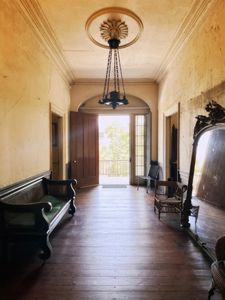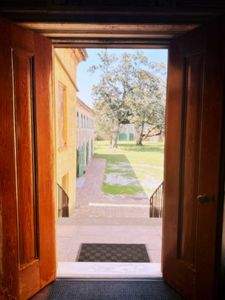Nestled among the cobblestone streets and historic charm of Charleston, South Carolina, the Aiken-Rhett House stands as a timeless testament to the city’s rich history and architectural heritage. Once the home of a prominent antebellum family, this magnificent mansion offers visitors a captivating journey through time, offering insights into the lives of its former residents and the cultural tapestry of the Old South.
A Historic Landmark
Built in the early 19th century, the Aiken-Rhett House is a striking example of Greek Revival architecture, showcasing grandeur and elegance that was emblematic of the period. The house was originally constructed in 1820 by John Robinson, a prominent Charleston merchant. It was later expanded and renovated by William Aiken Jr., a successful cotton planter, and governor of South Carolina.
The property remained in the Aiken family for over 142 years before it was acquired by the Historic Charleston Foundation in 1975, ensuring its preservation and allowing visitors to step back in time and experience the grandeur of the Old South.
A Glimpse into Antebellum Life

The Aiken-Rhett House offers visitors a unique opportunity to explore the past, stepping into the lives of the Aiken family and their enslaved labor force. Unlike many historic homes, which have undergone extensive restorations to mimic a particular period, the Aiken-Rhett House has been preserved in a state of “arrested decay,” providing an authentic and unvarnished look at its history.
As you wander through its stately rooms, you’ll encounter beautifully furnished parlors, an impressive dining room, and a grand staircase that once welcomed guests in the 19th century. The house also boasts a stunning collection of period art, furniture, and decorative items, offering a window into the opulent lifestyle of the antebellum elite.
 Behind the Main House
Behind the Main House
One of the most fascinating aspects of the Aiken-Rhett House is its extensive urban slave quarters and workspaces. Unlike many historic homes that downplay or ignore this part of their history, the Aiken-Rhett House shines a light on the lives of the enslaved people who lived and worked on the property. Visitors can explore the slave quarters, kitchens, and other outbuildings, gaining a deeper understanding of the complex relationships that defined life in the Old South.
Visiting the Aiken-Rhett House
Located at 48 Elizabeth Street in Charleston, the Aiken-Rhett House is open to the public year-round. It offers guided tours that provide historical context and insights into the people who lived and worked there. Visitors can explore the opulent interiors of the main house and wander through the preserved slave quarters and dependencies. The museum also hosts various events, lectures, and educational programs throughout the year, making it an engaging and informative destination for history enthusiasts of all ages.
The Aiken-Rhett House in Charleston, South Carolina, is more than just a historic home; it’s a living testament to the complexities of the antebellum era. By preserving the mansion in its authentic state of “arrested decay” and shedding light on the lives of the enslaved, the Aiken-Rhett House offers a powerful and thought-provoking experience for visitors. It stands as a reminder of Charleston’s rich history and its ongoing commitment to preserving and sharing the stories that have shaped this enchanting city.
*Photos taken by Tara Bittl, an amazing agent on our team!


